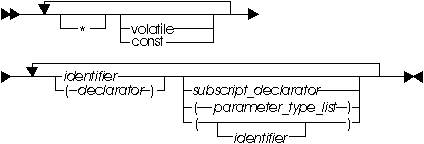
A declarator designates a data object or function. Declarators appear in all data definitions and declarations, and in some type definitions.

 You cannot declare or
define a volatile or const
function.
You cannot declare or
define a volatile or const
function.
 Class member functions can be
qualified with volatile or const.
Class member functions can be
qualified with volatile or const.
A subscript declarator describes the number of dimensions in an array, and the number of elements in each dimension.
A simple declarator consists of an identifier, which names a data object. For example, the following block scope data declaration uses initial as the declarator:
auto char initial
The data object initial has the storage class auto, and the data type char.
The following table describes some more declarators:
| Example | Description |
| int owner | owner is an int object. |
| int *node | node is a pointer to an int data object. |
| int names[126] | names is an array of 126 int elements. |
| int *action( ) | action is a function returning a pointer to an int. |
| volatile int min | min is an int that has the volatile qualifier. |
| int * volatile volume | volume is a volatile pointer to an int. |
| volatile int * next | next is a pointer to a volatile int. |
| volatile int * sequence[5] | sequence is an array of five pointers to volatile int objects. |
| extern const volatile int op_system_clock | op_system_clock is a constant and volatile int with static storage duration and external linkage. |
![]()
Declarations Overview
Block Scope Data
Declarations
File Scope Data
Declarations
Storage Class
Specifiers
Initializers
Type Specifiers
